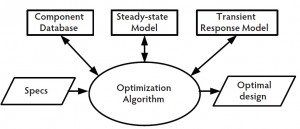Comprehensive and Practical Optimization for Point-of-Load Voltage Regulator Design
Yingying Kuai with adviser P. L. Chapman
This project develops a comprehensive and practical optimization solution for a complete multi-phase voltage regulator module (VRM) system. Early work in power electronics optimization assumed continuous variable space. This leads to solutions unsuitable for immediate implementation, as, in reality, many parameters are discrete. Dynamic voltage regulation during fast load transients has become a pressing issue for VRM dedicated to low-voltage, high-current devices. Much research has been conducted for VRM load transient design, but good results often come at a price of more components or complexity.
Only a few methods have been developed to find an optimal solution, and they are limited to passive filtering components.
In this project, the problem is approached comprehensively. The power stage and the controller are designed as a whole system. Design variables include the number of phases, passive components as well as operation parameters such as switching frequency, and controller bandwidth. Modeling combines time and frequency domain analysis to take into account transient performance, in addition to efficiency and steady-state specifications. Flexibility is improved by setting total material cost as the objective function. The solutions can be immediately implemented because they represent actual devices on the market. Stochastic methods such as pattern search and genetic algorithm are utilized as the optimization engine. The whole system structure is shown in Figure 2.
As an example, a VRM system is optimized for a typical 12V to 1V operation condition. Figure 3 plots design solutions for gradually increasing transient current slew-rate. The optimization system chose the same inductor and capacitor combination and increased the number of phases to achieve faster transient response without sacrificing efficiency. The optimization tool is valuable for investigating cost reduction methods for a given VRM system, or for initial project validation. Experiments are being conducted to confirm modeling predictions.
This research is supported by the Grainger Center for Electric Machinery and Electromechanics.
